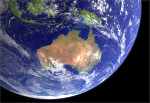|
|
 |
|
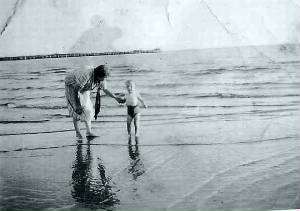
|
| 1940 - at Port Melbourne Beach, with Nana |
The image at the left of the banner shows beach styles of the early 1920s!
THE BEACH
My first trip to the sea was in September 1940! This was to Port
Melbourne Beach - the picture tells the story,
my Grandmother enticing me into the water!
By 1946 I had become a "little beach boy", mainly as a result of visiting our bungalow at West Altona, which was adjacent to the beach.
In 1949, I undertook swimming lessons at the Richmond Pool and Hawthorn Baths - no heated
pools in those days!
In 1953-1955 whilst at Camberwell High School my preferred sport was swimming, going to the
outdoor Camberwell Baths which were adjacent to the school.
In the years 1965-1966 I was at RMIT full-time, almost next-door to the well-known City Baths,
where I went often during breaks, These Baths had been there for what appeared to be hundreds of years, and are still
popular today!
When I got my first car in 1959, I was able to go to many interesting coasts and beaches near
to Melbourne.
In 1968 I went to the Fiji Islands with a mate, staying at a bungalow on the Coral Coast,
on the south of the main island. The swimming and snorkelling there were fabulous!
In later years, I visited many Pacific and Asian destinations, several of which were beach
places on the coasts, including New Hebrides, Malaysia, Tahiti and New Caledonia.
In 1997, I became a member of the local Aquatic Centre here in Box Hill, and have pursued
lap swimming several; times a week ever since. I also do voluntary work at the Centre in assisting disadvantaged people undertake
water-based activities
I also enjoy beach-walking - beachcombing - rockpooling, exploring the coastlines around Westernport
and Port Phillip Bays.
|
|
| 1904 - Melbourne City Baths |
|
|
| 1951 - Hawthorn Baths - schools swimming competition |
THE MELBOURNE CITY BATHS
This is a historically significant building, at 420 Swanston Street.
The Melbourne City Council opened the first Melbourne City Baths on 9 January 1860 which housed
public baths. The objective was to stop people from bathing in the Yarra River,
which by the 1850s had become quite polluted and the cause of an epidemic of typhoid fever which hit the city resulting in
many deaths.However, people continued to swim and drink the water. The Baths were leased to a private operator, but lack of
maintenance resulted in such deterioration of the building that the Baths were closed in 1899.
New baths were opened on 23 March 1904. Strict separation
of men and women was maintained, right down to separate street entrances. Two classes of facilities were maintained, with
second class baths in the basement and first class baths on the main floor. Mixed bathing was introduced in 1947 and the popularity
of the swimming pool began to increase
The Baths now house a swimming pool, squash courts, sauna, spa and a gym, The swimming pool is divided
into four lanes, an Aqua Play lane, a Medium Lane, a Fast Lane and a Slow Lane (or Aquatic Education, when swimming lessons
are given) to cater for all types of swimmers.
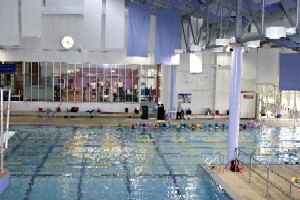
|
| 2011 - Whitehorse Aquatic Centre - main pool |
THE WHITEHORSE AQUATIC AND LEISURE CENTRE
Twenty
minutes from the heart of the city, and very close to my home here in Mont Albert, the Whitehorse Aquatic and Leisure
Center is one of the best equipped in the eastern suburbs, There is a 25 metre heated indoor pool and diving area, while outside
there is a 50 metre heated pool, ideal for the warmer months. Squash, tennis, netball and basketball courts are available
for hire - there is modern gymnasium and circuit room.
Swimwear fashions for all ages, men and women, are prominent at my local Aquatic Centre,
and reflect current community styles and expectations. Male styles are dominated by boardshorts, jammers, trunks, and speedos
- all of which are available for sale at the Centre shop.
Before the centre was built, people swam in the Surrey Dive, in the 1920s
onwards, a disused quarry of vast depth, now an ornamental lake next to the Centre.
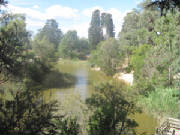
|
| 2011 - Lake, site of former Surrey Dive |
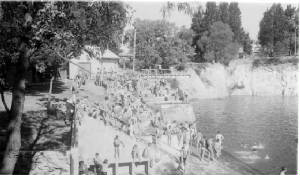
|
| Surrey Dive c1940 |
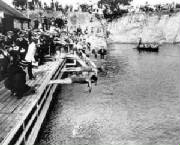
|
| 1920 - Surrey Dive |
|
 |
|
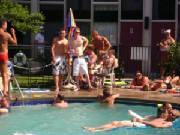
|
| 2011 styles - boardshorts at the pool |
SWIMWEAR FASHIONS OVER 100 YEARS!
I grew up in an era when male and female swimwear styles and fashions were passing through a
period of significant transformation and liberalisation!
For much of recorded history, men bathed in the nude; in some settings during the classical antiquity
period, both men and women partially covered themselves with loincloths. By and large, however, because men and women tended
not to swim together, men favored diving into the water either in their underwear or completely naked.
It wasn’t
until the Victorian era, when rail travel increased the popularity of seaside holidays, that men's beachwear was introduced
and became the norm.
Early versions of men’s swimwear consisted of a fitted long-sleeved wool garment with legs.
In the 1900s, obsessive concern with modesty led to the “Bathing Suit Regulations of 1917”, whereby men were required
to be completely covered, resulting in beachwear that included skirts, flannel knee pants and vests.
Finally, in 1937,
following the promotion of a line of swimsuits by Olympic swimmer Johnny Weismuller, American men reclaimed the right to go
topless at the beach.
From then on, swimming trunks became the most commonly worn beachwear for men in one form or
another. In the '60s, vinyl panels were added, while in the '70s, cutoffs were popular, and Lycra Speedos dominated the '80s.
The revival of surfing culture in the '90s popularized the boardshort, and the influence of Brazilian culture brought additional
options to the male swimsuit market.
Here in Melbourne, the Collingwood Baths were
"men only" in the early 1920s and swimming costumes were optional. Around Port Phillip Bay were various "beach baths" - mixed
company was not permitted, and gender separation provided access to the these establishments only at specified times
for each sex.
In the era of the 1920s and 1930s, the few Melbourne-based surburban swimming pools were gender neutral,
but heritage photos of the time show that the vast majority of participants were male.
As a kid in the 1940s, I remember having to wear a ridiculous black woollen swimming single-piece
costume at the beach, neck to just above the knee. The top was like a modern-day athletic singlet - the bottom was in two
parts, consisting of what we would later call "shorts" with a wrap-around flannel "skirt" (like an apron!)
Being wool, this entire contraption was extremely heavy when wet, was horribly unconformatble. itchy,
and attracted sand and bits of seeweed from the beach!
Later, the "rules" changed - the tops disappeared, and then the skirts became part of history!
Fashions for all ages, men and women, are prominent at my local Aquatic Centre, reflect current
community styles and expectations. Male styles are dominated by boardshorts, jammers, square-cuts, trunks, and speedos - all
of those are available for sale at the Centre shop.
Attitudes and styles have changed since the 1850s!
|
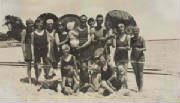
|
| 1927 - styles |
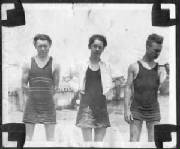
|
| 1920 - styles |
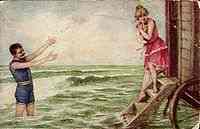
|
| 1910 drawing - come on in, the water's fine! |
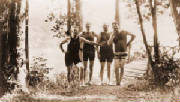
|
| 1910 - swimwear fashions! |
|
|
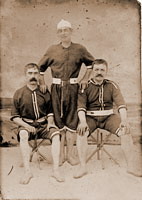
|
| 1880s - what people wore to the beach then! |

|
| Style of 1858 |

|
| 1910 fashions |
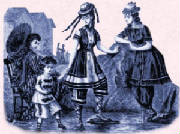
|
| 1880 fashions |
|
|
 |
|
|
 |
|
|
 |
|
|
|
|
|
|

|
| 2011 swimwear styles - jammers |

|
| 2011 -swimwear style - competitive gear |
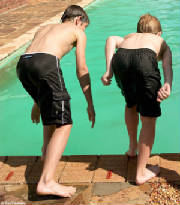
|
| 2011 - fashions at the pool! |
|
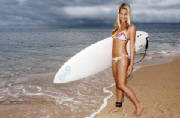
|
| 2011 - fashions |
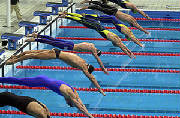
|
| 2011 - Olympics swimwear |
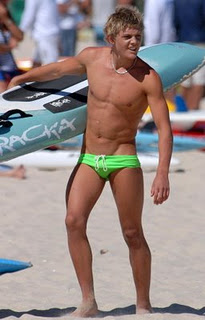
|
| 2011 - Surfer swimwear fashion |
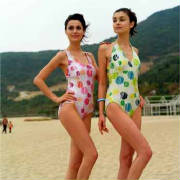
|
| 2011 fashions |
|
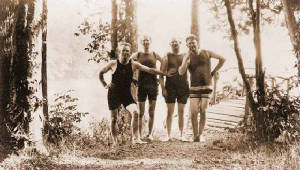
|
| 1910 - swimwear fashions! |
|
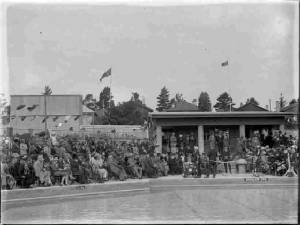
|
| 1927 - opening of Camberwell Baths |
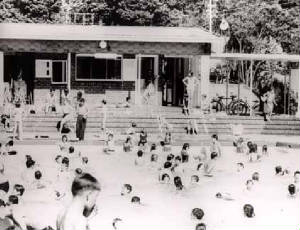
|
| 1960 Camberwell Baths |
THE CAMBERWELL BATHS
The other swimming
hole which I frequented often during the summer months in the 1950s was the Camberwell Central Baths, located just off Riversdale
Rd, Canterbury.
These Baths were opened in 1927, on the site of a former Chinese market garden.
In 1941, Camberwelll High School (my school!) was opened next door to the Baths. In 1963, a wading pool was added. Being adjacent to the School,
it was used for school swimming events.
By that time, new larger modern Pools had opened in 1961 at Camberwell (North) at Balwyn, and
in 1963 at Camberwell (South) in Hartwell.
In the mid 1960s, the centre was closed down, and the the site used for construction of
the new Assembly Hall/Gym for the school.

|
| 1927 - Camberwell Baths |

|
| 1927 - Camberwell Baths |
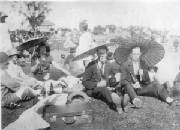
|
| 1921 - St Kilda - parasols were very chic! |
|
Most of the images in this site are thumbnails.
Click on any image to see a full size verson in a new window
If you would like to contact me about my Autobiography, you can do this at
|
|
|
 |
